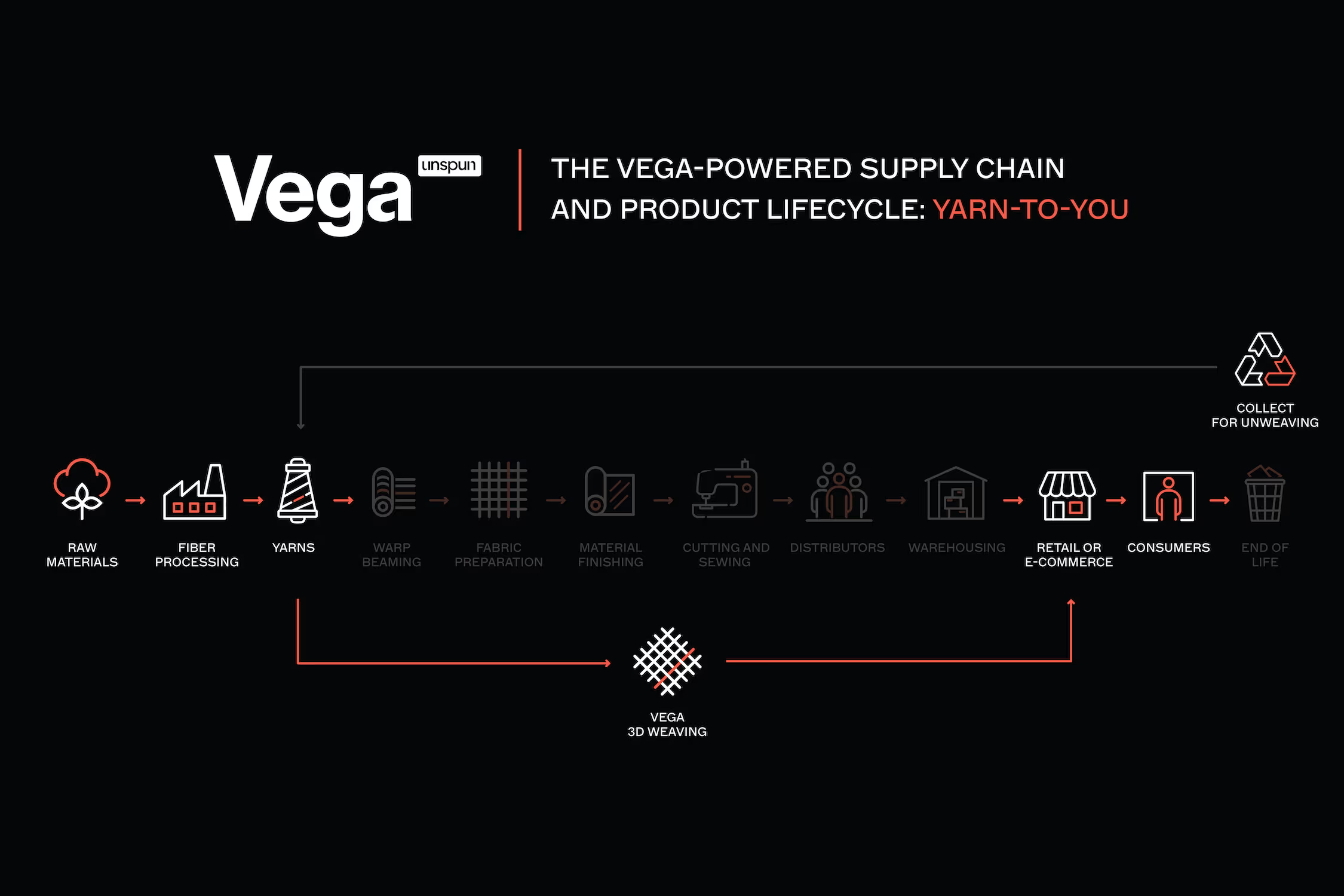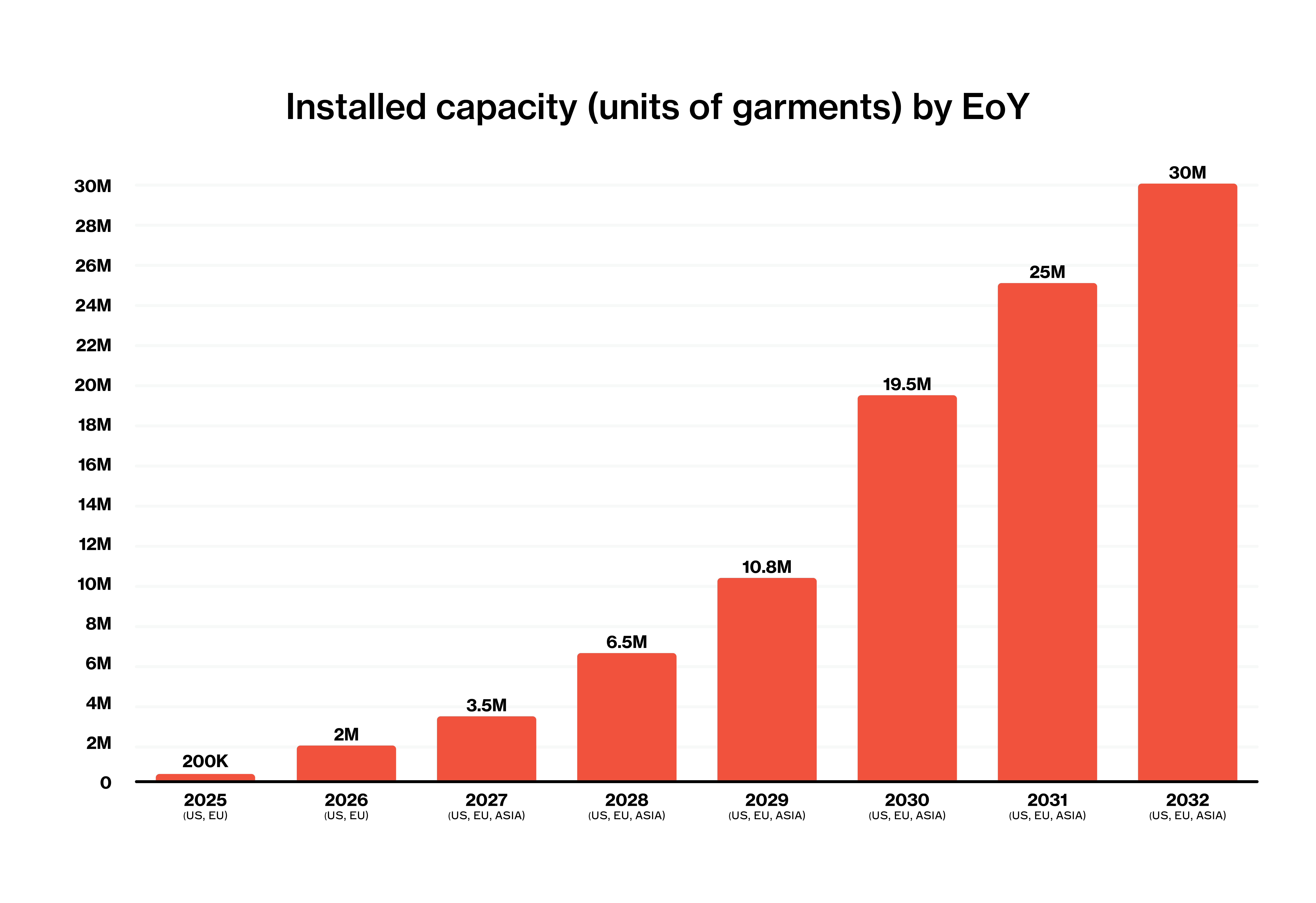Hi! We’re unspun. We make 3D woven pants and we also make custom-fit jeans.
Wait, what? 👀
When people ask what unspun is all about, this is basically our pitch. It’s not uncommon for someone to react with some form of “what?” 😅
If you asked yourself the same thing, you’re not crazy. We’re doing two big things to transform the way the fashion industry works at the same time. Some basic explanations are in order.
And actually, we’ve shared those explanations already, at least in regards to how our 3D weaving and custom-fit technologies relate to (and differ from) another. But we’d like to clarify some basic points about how our 3D weaving tech relates to the world. 🌏
So here’s a more outward looking version of what unspun is, and what the 3D weaving technology we’re introducing means. Cheers.
What is unspun?
We’re a tech company and an apparel brand. We also manufacture clothing. You can think of us as two parts.
On the one hand, we’re developing a novel technology that 3D weaves clothes. On the other hand, we design custom-fit jeans based on a body scan.
As of now, the two parts of unspun are separate: whereas we use 3D weaving to make clothes in sizes, we use cut and sew manufacturing to make jeans bespoke. As we constantly improve both our 3D weaving and custom-fit technologies, we aim to unite them in the future.
unspun is a mission-driven enterprise. Our goal is to radically reduce the carbon impact of the fashion industry. We strive to achieve this by making clothes using fewer resources, making clothes in response to demand, and making clothes closer to where they’re sold.
Change the paradigm; change the world.

What is 3D weaving?
3D weaving is an entirely new way to manufacture apparel. It combines the process of making a textile into the process of making a garment. In the act of weaving yarns together to create fabric, a 3D weaving machine produces a piece of clothing itself.
Let’s say you’re wearing a typical pair of pants mass-produced in sizes. To make those pants, a factory wove a roll of fabric using a loom. A different factory then bought that roll of fabric, cut it up, and stitched the pieces together with a sewing machine.
Now imagine unspun made that same pair of pants. Using one of our Vega™ 3D weaving machines, we wove thousands of yarns together to make a seamless tube of fabric. That tube is a pant leg. Then we wove a second tube to make another pant leg. And then we stitched the legs together at the crotch seam to make a pair of pants —all in the same microfactory.

Is circular knitting the same as 3D weaving?
No. Circular knitting is not the same as 3D weaving.
Both textile manufacturing methods are similar in the respect that they create three-dimensional tubes of fabric. However, knit fabrics are made from loops of yarn, and woven fabrics are made from straight lines of yarn.
To produce fabric, circular knitting machines link yarns together by running a series of loops, called stitches, through stitches formed below them. This construction gives knitwear its defining flexibility, but is less durable than woven cloth, and requires more yarn per square inch. The fashion industry has used circular knitting machines for decades to make garments such as socks, t-shirts, and (more recently) yoga pants, as well as to make upholstery.
By contrast, our Vega™ 3D weaving machines interlace yarns together by crossing one over the other at right angles in an upwards direction, a process several times faster than circular knitting. And because it’s constructed from taut yarns, 3D woven cloth is stronger than knitwear despite being made with less yarn overall.
We invented 3D weaving machines and the software needed to operate them; this technology has never been used before. Currently, we primarily produce high fashion bottoms with our Vega™ 3D weaving machines, though we’ve begun making everyday pants, and are exploring how to produce sweaters and pillows as well.
Is there a difference between 3D printing and 3D weaving?
Yeah. There is. Asked another way, when is the last time you printed something with yarn?
On a basic level, 3D printing can create three-dimensional forms that resemble the tubes of fabric created by 3D weaving. Yet 3D printers do not make objects using yarns. Consequently, 3D printed wearable fabrics are best characterized as a synthetic mesh as opposed to a woven textile.
3D printing is an additive process. That means 3D printers build up objects layer by layer, most often out of plastic. Generally, these machines render fabric in diverse three-dimensional shapes through a few techniques, such as by assembling chain mail or fabricating large perforated planes. In effect, the properties of 3D printed fabric may mimic those of a woven cloth, though the construction, feel, and appearance of that fabric will be notably different.
Of course, 3D weaving is still weaving, humanity’s oldest means of transforming fibers into cloth. No nozzle necessary. What distinguishes 3D weaving from 3D printing isn’t merely the attributes of woven cloth —although, the ability to highly customize the appearance of the pattern of interlaced yarns, called a weave, is unmatched by 3D printers.
More than that, albeit in fewer shapes, our Vega™ 3D weaving machines are able to produce three-dimensional fabric in significantly less time than 3D printers. 3D weaving machines can also use virtually any material that can be turned into yarn, including various plastics.
Why is 3D weaving important?
That’s the million dollar question. 3D weaving changes everything about how our clothes are made.
3D weaving is a technological breakthrough. One of our Vega™ 3D weaving machines can produce an article of clothing in minutes rather than months. Vega™ machines also waste far less material and use far less energy than cut and sew manufacturing methods.
This is only possible because our Vega™ software controls how an article of clothing is produced to a degree not yet seen. As a Vega™ machine creates a tube of fabric, our software can manipulate its shape in real time by adjusting the diameter of that fabric.
In other words, 3D weaving designs the cut of a piece of clothing into the fabric itself.
Remember your typical pair of pants? One overseas factory wove the roll of fabric, and another cut it up to make the pants. Actually, the second factory used the roll to make as many pants as it could. Whether there’s demand for all of those pants doesn’t exactly matter: that’s just how the fashion supply chain functions.
It took a global logistical effort to sell those pants to you. Big rigs, ships, planes, and trucks transported them around the world between manufacturers, to shippers, to a retailer you can access. Then you bought a single pair. As for the other pairs that didn’t sell? They’re about as good as trash.
Your pair of 3D woven pants, meanwhile, bucked most of that supply chain. Recall that a Vega™ 3D weaving machine makes clothing faster and using fewer resources. That means it can be set up and operated in your country, your region, and even outside your city.
So a microfactory near you made your unspun pants. It either made a single pair on demand (after you bought it) or a small batch of pants just in time (right before you bought a pair). That way, the manufacturer didn’t have to guess the demand for these pants, and the retailer didn’t have to store a large inventory of them. A van drove dozens, not thousands, of miles to get your pants to your local store or your mailbox. And because the pants were made in such a small quantity, after you bought a single pair, few if any unsold pairs were left over.
By changing the way we make clothing, we change why we make it, where we make it, and when we sell it. We change everything.
The best part? Your unspun pants have the same style and practicality as your typical pair of pants. But they’re actually made sustainably.

What happens next?
We’ve imagined, developed, and implemented 3D weaving technology with a single-minded purpose: to change the paradigm of the fashion industry, and consequently, to change the world.
No big deal or anything. 😀
We’re not out to change the world alone though. We want 3D weaving to flourish across the globe with the involvement of everyone, for the benefit of all.
Do you want to refashion fashion? There are a few ways you can join us.
Do you represent or work closely with a fashion brand or apparel manufacturer? Or are you a journalist, blogger, or influencer? Either way, we’d like to chat.
Do you appreciate new tech, good design, and high fashion? We released the first ever 3D woven pants for sale to the public in early 2024. Visit our Shop for the latest.
Or are you simply excited about a future defined not by good intentions, but by intentionally doing good? So are we. Help us spread the word; connect with us on socials and let your friends know supporting brands that do good is a good look.
We can change the world for the better. Let’s make it happen.

How can unspun help?
"Key takeaway: unspun has been developing 3D weaving to localize manufacturing since our founding and can produce and scale to 1M+ units within the next 12 months."
Since 2018, unspun has been building proprietary 3D weaving technology and software to make onshore and nearshore apparel production a reality. Our proven system slashes lead times from weeks to minutes, taking pants from yarn to finished garment in a single, seamless process. This process enables labor production time to reduce from 40 minutes to under 15 minutes. It works because it negates the need for many traditionally time-consuming apparel production steps.

Cost is no longer a barrier: we’re scaling through offtake agreements with major partners like Decathlon and Walmart. We’ve already launched a pilot facility in California and are preparing to open full-scale plants in the US and Europe.
Backed by years of policy work—spanning multiple administrations—we’re on the verge of announcing a US manufacturing consortium alongside leading brands. To power this next phase of growth, we recently closed a $32M funding round, and have committed a significant portion of the funding in helping to onboard brands and manufacturers in the new age of automated apparel manufacturing.
Below is our scheduled capacity:

Come see for yourself!
Experience the future of local and automated apparel production with us. We’re hosting exclusive in-person and virtual demonstrations of our 3D weaving technology. Join us!
🇺🇸 San Francisco
Wednesday, April 23, 2025; 5:30-8:30pm
unspun HQ, 6655 Hollis Street, Emeryville, CA
An evening summit hosted by unspun™ and American Circular Textiles. Join us for networking, panel discussions, and hanging out in the world’s first 3D woven powered-microfactory.
RSVP via this registration link.
🇭🇰 Hong Kong
Friday, May 9, 2025, 9:30 - 11:30am
unspun Studio, Shop B2, G/F, 6-10 Shin Hing Street, Central, Hong Kong
An interactive breakfast experience with a live virtual tour of the world's first 3D weaving-powered micro factory and our technology with unspun’s founders
RSVP via this registration link.
🇪🇺 Europe (Coming Soon)
Summer 2025
Secret location
Experience the entire end-to-end process of localized apparel production with 3D weaving in Europe, and be the first to see Vega in action.
Register here to get on the list.
🔗 Can’t make these dates?
Schedule a time to chat or a virtual demo. We’re happy to discuss our pipeline, share machine performance data, or walk you through our upcoming plans.
.svg)